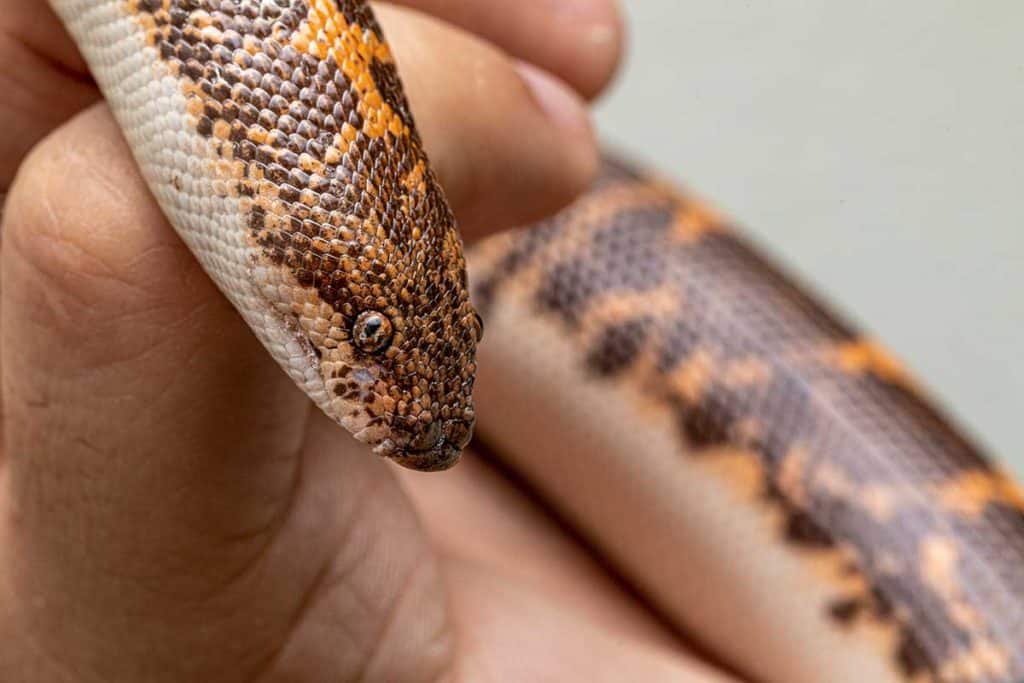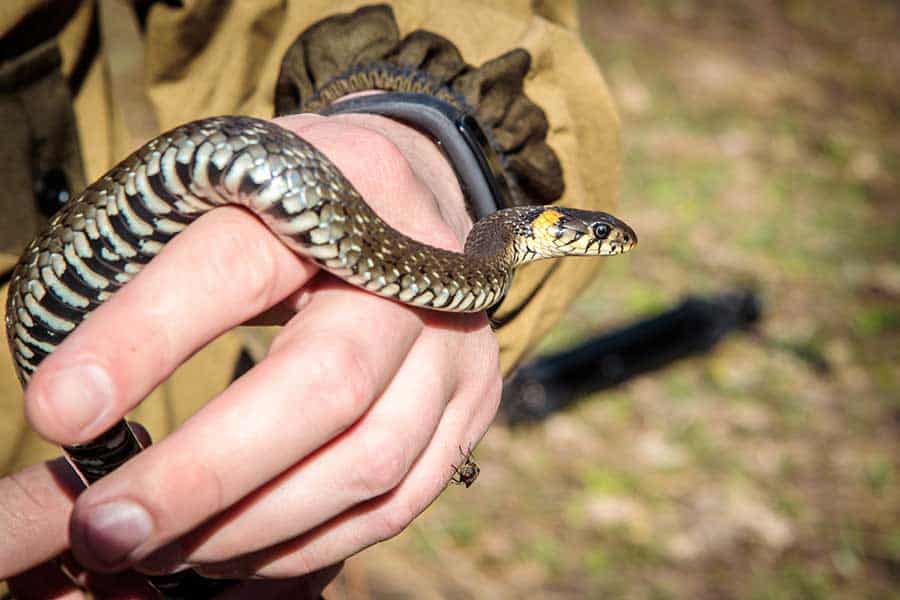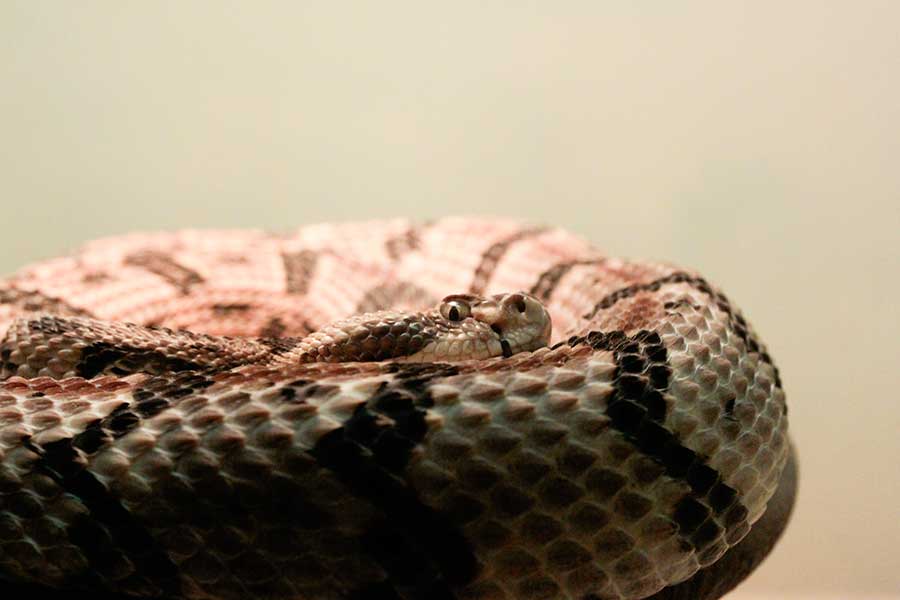
Water is vital for the survival of all animals, regardless of whether they are furry, feathered, or scaly. Understandably, a dehydrated snake is a very worrying sight to any reptile owner. Sometimes, dehydration can be from neglect, illness, or even a simple beginner mistake. Other times, the cause is unknown.
Fortunately, dehydration in reptiles shows very clear signs and symptoms, so identifying them is fairly easy. Treating dehydration in snakes is a fairly simple process if the dehydration is caught early and is a mild case.
If the case is severe, however, it will require a trip to the vet, as more drastic measures will need to be taken to rehydrate your pet.
Read on to learn what causes dehydration in snakes, their symptoms, and what you can do to treat and help your scaly baby recover.
Signs and Symptoms of Dehydration
Do snakes drink water?
Yes, snakes drink water. They typically drink by immersing their lower jaw in the water and then use muscles in their mouth to pump the water down their throat.
How often do snakes drink water?
Snakes need to stay hydrated just like every other living creature, although they generally don’t need to drink as often as mammals. Some snakes can go for days without water, so you should check the water requirements for your variety. Snakes get a lot of their water from their food, but they still need to drink. Different species of pet snake and different environments have a big impact on how ofter they need to drink. Some snakes in very dry environments might get most of their water from the prey they eat, while others in more humid or aquatic environments might drink more frequently.
Ask the Expert
Ask The Expert

Symptoms of a dehydrated snake
Identifying a dehydrated snake is a no brainer, Its sunken eyes, dry skin, weak and lethargic movement always gives it away. Though snakes do not take much water and naturally move stealthily, one could still tell they are dehydrated by the way their skin loses elasticity and becomes wrinkled especially during shedding. A dehydrated snake would also have problem shedding due to dryness of the skin, the shedding becomes inconsistent and difficult, taking longer than usual. When observed properly, the mucous membrane of a dehydrated snake becomes pale, dry and sticky.
Dr. Jerry is the lead Veterinary manager at Ectovis, supervising clinical and non-clinical activities to provide a better pet health service to pet owners and their pets.
Dr. Jerry Ayaebi (DVM, CEP) received a DVM degree for the University of Nigeria, Nsukka. He has also attained a certification in data analysis and design.
Follow him on Linkedin here
Causes of Dehydration in Snakes
Dehydration just means a lack of adequate water. However, it can happen in a number of ways. When keeping a snake in captivity, there are a lot of factors you will need to keep in mind to avoid causing your snake to become dehydrated. Below are some of the most common causes of this condition in snakes.
Lack of Water
Snakes need to drink water just like any other pet you might own. However, they do not always drink water in the snake way a dog or cat might. Dogs and cats can go and find fresh water if they really need it, but snakes cannot leave their enclosures.
Snakes need to be provided with water in one of two ways depending on the species
One way you can provide clean water is by putting a
If you're worried about unintentionally raising the humidity in your snake's enclosure to a dangerous level, you can always remove the water dish for a few hours a day and then put it back in to allow your snake to drink from it for a certain time each day. Alternatively, you could remove the snake from the enclosure when you present water to them each day.
Another way to provide water to your snake is by using a dripping system or by manually misting them with a spray bottle to create water droplets on their bodies or the branches in their enclosures that they can lick off as needed.
Most importantly, snakes need fresh drinking water that is always available to them. Without the appropriate amount of water, they will become dehydrated and develop other health issues like stuck shed (dysecdysis), constipation, and impaction. You don't need warm water, room temperature fresh water or lukewarm water is absolutely fine.
Incorrect Humidity
Snakes need varying levels of humidity in their enclosures depending on their species. Humidity is provided in several ways. Your snake's enclosure can potentially attain the appropriate humidity if you simply place it in a location that happens to already have the correct humidity levels for your snake, but in most cases, you'll need to make some adjustments to the enclosure.
Humidity can also be manufactured by installing an automatic misting system or by manually misting the enclosure daily depending on the humidity needs of your snake.

Installing a hygrometer is essential in every enclosure as it will allow you to monitor the humidity levels closely. From there, you can make changes to the misting frequency, lighting, water dish placement, substrate, and more to fine-tune the humidity level.
If the humidity is too low in the enclosure, then the moisture will be pulled from your snake's skin. Their skin is quite permeable, so having humidity ranges that are too low will result in dehydration very quickly.
Illness
Snakes can and do get sick. One of the most common illnesses is respiratory infections due to too high or too low humidity. This is why researching your snake's species is so important when setting up the enclosure so you know the amount of humidity they need to thrive. Getting the humidity wrong can cause serious problems.
Another serious health concern are parasites. Parasites can cause diarrhea, which will rapidly dehydrate your snake, as it cannot hold onto the liquid in its digestive system that would normally be absorbed by its body.

Signs and Symptoms of Dehydration
There are several key symptoms of dehydration you'll need to keep an eye out for to determine if your snake is getting enough water. The most common and prominent signs are the following:
Wrinkled Skin
Just like chameleons, bearded dragons, and geckos, mild dehydration in snakes will result in loose and wrinkly skin.
A snake can normally have some wrinkles in their skin; however, these wrinkles will be smooth and taut. A snake suffering from dehydration will have many wrinkles that are loose and can be moved around easily.
Some dehydrated snakes may also develop a solid wrinkle down the length of their body, either on their sides or down their spines.
Lack of Skin Elasticity
When a snake's skin becomes dehydrated, it loses elasticity or stretchiness. To get an idea of your snake's skin elasticity, gently pull a small section of their skin folds away from the body and gently pinch it between your fingers and let go. If it does not bounce back immediately, your snake has a loss of skin elasticity and is dehydrated.
The longer the skin stays pinched together on its own without retracting, the more severe the case of dehydration.
You can also test this out on yourself to determine your own level of hydration! Lay your one hand flat, and with the other hand, pinch the skin on your middle knuckle. It should stand up on its own momentarily before bouncing back to normal. If it stays up, then grab a glass of water!
Dry Eyes and Cracked Eye Caps
Dehydration causes snakes' eyes to look dry and cloudy.
Snakes have coverings over their eyes to protect them. This covering can get so dried out that it splits and cracks. If you can see that the membrane over either eye is cracked, your snake is severely dehydrated and needs to get to the vet as soon as possible.
However, make sure you do not mistake this for when they are going into shed. When snakes are preparing to shed their skin, their eye caps will also shed away and they turn cloudy temporarily, which gives them a bluish appearance. That is why going into shed is also called “going into blue.”
Dry Mouth
Dehydrated snakes will also have dry mouths. This is a little more difficult to see, especially if your snake is a smaller (or more aggressive and less handleable) species. However, a dry mouth will look very pale and sticky or completely dry.
Dry, Flaky Skin
As I have mentioned, snake skin is permeable, which means that water can be drawn out of it into a low humidity environment. If the skin is drying out, it can crack and become flaky, in turn causing it to look very similar to how your lips would look and feel if they were dried out and chapped.
Stuck Pieces of Shed
If your snake has become dehydrated during its shedding phase, then it will not be able to shed its old skin completely. This will result in some stuck shed around its eyes, mouth, and tail. These are typically the areas that snakes struggle with most when shedding. Stuck shed is also commonly known as dysecdysis.
Refusing Food
Snakes who are dehydrated will not eat or even show interest in their food. Since they do not have enough moisture in their bodies to facilitate digestion, your dehydrated scaly friends usually won't want to eat. Prolonged dehydration can cause a snake to lose its appetite, so it is one of the most important signs to look out for.
Snakes can refuse food for many reasons, such as it being mating season, their enclosure temperature being too cold, brumation, or stress, so make sure you are keeping an eye on their health in a holistic manner.
Lethargy
Lethargy simply means excessive, prolonged tiredness and an unwillingness to do anything due to a lack of energy. Being dehydrated will take a lot of your snake's energy away from it as its body struggles to keep up with its functions without water.
In addition to the lack of energy purely from dehydration, refusing food will also restrict the number of calories your snake has to burn. Snakes are ectothermic animals, or cold blooded, so their lethargy can be mistaken for warming up. Make sure your enclosure or tank has a
Muscular Atrophy
Muscular atrophy is the wasting away of muscle tone and muscle mass. Muscular atrophy will come from the snake not moving around as much as usual due to lack of energy from a lack of food and water.
When a snake's muscles start to atrophy, it is a sign of severe dehydration, and you need to get your snake to the vet as soon as you can. When muscles break down, they release proteins into the snake's bloodstream that can cause organ failure.
Sunken Eyes
Severely dehydrated snakes will have sunken eyes. Their eyes will look like they are sinking back into their skulls. It is a very noticeable and scary sight. If you come across a snake that has sunken eyes and other signs of dehydration, they require an urgent trip to the reptile veterinarian.
Dehydration Treatment
Dehydration in snakes can be mild or severe. If you manage to catch the case while it is still mild, you can usually treat it at home without a trip to the vet. However, if it is more severe, there are steps a vet can take to help boost your snake's hydration such as providing fluids via injection.

If your snake is mildly dehydrated, these are some of the steps you can take to treat it at home:
1. Provide Fresh Water in a Dish
Change out the shallow water dish your snake has in its enclosure. Your snake might have been uncomfortable with the one that was originally in there. Make sure it is large enough for the snake to soak its body in if it chooses.
2. Provide Fresh Water From a Dripping System
Try misting directly onto the branches of the enclosure to create water droplets next to your snake. If your snake will tolerate it, mist their bodies directly. If they start drinking from the water droplets, set up a dripping system in the enclosure. Some snakes prefer drinking from water droplets rather than standing water in a deep water dish.
3. Check Temperature and Humidity Settings
Check that your hygrometer is still working properly and not giving you false readings. Then check that your system of providing humidity (whether manual misting or an automatic system) is enough and does not need to be increased.
Snakes need specific environmental temperature for different species, and some species like warmer or cooler temperature. Many snakes like in an arid climate in their natural environment, and the wrong humidity can cause respiratory issues, fungal issues or issues with scale rot. The humidity is one of the most important ways to keep your snake in peak condition.
4. Soaking
Soaking is a great way to help your snake with dehydration.
For some snake species, you'll be able to keep a large bowl of water in their enclosure, provided it doesn't interfere with the enclosure's humidity too much. However, for other species that need very dry conditions, this won't be possible, and you'll need to soak them in a bowl outside of their enclosure from time to time to assist with shedding and boost their hydration.
To soak your snake, get a container or a bowl that is large enough for your entire snake to comfortably fit in at once. The container should be filled with clean, fresh, warm (but not hot) water. The water should be roughly the same temperature as the ambient temperature in their enclosure.
Let your snake soak for 10 to 20 minutes every day until you see an improvement in their symptoms.
5. Electrolyte Soak
An electrolyte bath is like a soak on steroids. Prepare your normal soaking container, but add electrolytes to it. You can use a sugar-free energy drink that is high in electrolytes or you can use an electrolyte formula.
Soak your snake for 10 to 20 minutes a day until you see an improvement. Always gently rinse your snake's body off after the electrolyte bath before returning it to the enclosure.
6. Consider a humidity chamber or humidity hide
Some snakes, especially tropical species, need the humidity levels to remain high so their skin doesn't dry out. You can make a chamber yourself out of a plastic box and a humidity-absorbing substrate, such as sphagnum moss. A plastic humidity box is fine, but doesn't look very nice!
If you want to buy one, there are some great options that will fit in with the aesthetic of your enclosure or tank. Some of my favorites look like rocks or leafy hides, and they are great value, easy to use and stay at the snake's preferred temperature. A humidity hide is also perfect to help snakes regulate their body temperature.
Avoid using cheap substrate, and make sure you are using the correct cage environment.
FAQs on Dehydration in Snakes
How do snakes drink water?
Snakes like ball pythons do not drink by taking large gulps of water and swallowing them. There are sponge-like structures on their lower jaw that draw the water up into their mouths for them to swallow down. This process is called capillary action.
What can I do to prevent my snake from getting dehydrated in the first place?
Research your snake's needs. Make sure you understand what requirements your species needs as far as temperature, humidity, diet, substrate, etc., and make sure you keep a careful eye on their enclosure's humidity and temperature settings.
Feed your snake frozen/thawed prey and not live prey. Frozen/thawed prey contains more moisture than live prey does. Frozen/thawed prey is also safer to feed your snake and less stressful for them to eat.
Do all snakes have to have a humid hide in their enclosure?
Not all snakes need humid hides to be set up in their enclosures permanently. In fact, certain species of snakes will react badly to having a constant source of intense humidity. However, some snakes who thrive in more moist conditions will benefit from having the humid hide in their enclosure permanently.
You will need to do your research to determine which option your snake will need.
All snakes do benefit from a small boost in humidity while they are shedding. Therefore, when you know your snake is about to shed or is in the process of shedding, you can put a humid hide in their enclosure, if they do not have one permanently, to help ease the shed.
How do I set up a humid hide?
A humid hide is any type of solid, opaque container that is large enough to fit your snake inside. You should line the container with a substrate that retains moisture well like sphagnum moss or paper towels.
The moss or towels should be moistened every day. This hide will provide a space for your snake to absorb extra moisture to ease the shedding process and prevent shedding skin from getting stuck.
Can I keep all of my snakes at the same humidity range?
Snakes need different humidity ranges according to their environmental needs. Some snakes need extremely high humidity levels, such as the Brazilian rainbow boa (75% to 90%), and some need very low humidity, such as the rosy boas and corn snakes (40% to 50%).
Make sure you research your particular breed of snake very carefully so you can set up their enclosure's humidity and temperature settings correctly to avoid health problems.
Slithering Off…
A dehydrated snake needs quick and attentive care to reverse the effects of dehydration. Dehydration does not always mean death for the snake; however, it can lead to kidney failure, liver damage, and heart failure if not promptly treated.
You can identify the signs and symptoms of dehydration in your snake at home and treat your scaly baby yourself! Prevention is always better than the cure, so make sure you stay on top of your snake's health.






